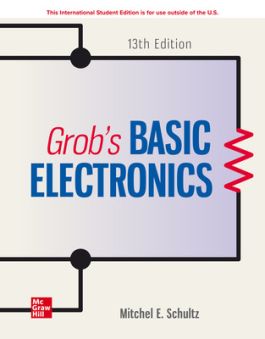Grob's Basic Electronics ISE
After purchasing your eBook, login to the McGraw Hill Bookshelf website and redeem the access code from your order confirmation email.
- Access your eBook online or offline
- Easily highlight and take notes
- Fully searchable content
- Syncs across platforms
NOTE: eBook purchase does not include Connect homework or adaptive SmartBook assignments
1) Electricity
2) Resistors
3) Ohm’s Law
4) Series Circuits
5) Parallel Circuits
6) Series-Parallel Circuits
7) Voltage Dividers and Current Dividers
8) Analog and Digital Multimeters
9) Kirchhoff ’s Laws
10) Network Theorems
11) Conductors and Insulators
12) Batteries
13) Magnetism
14) Electromagnetism
15) Alternating Voltage and Current
16) Capacitance
17) Capacitive Reactance
18) Capacitive Circuits
19) Inductance
20) Inductive Reactance
21) Inductive Circuits
22) RC and L/R Time Constants
23) Alternating Current Circuits
24) Complex Numbers for AC Circuits
25) Resonance
26) Filters
27) Three-Phase AC Power Systems
28) Diodes and Diode Applications
29) Bipolar Junction Transistors
30) Transistor Amplifiers
31) Field Effect Transistors
32) Power Amplifiers
33) Thyristors
34) Operational Amplifiers
Appendix A - Electrical Symbols and Abbreviations
Appendix B - Solder and the Soldering Process
Appendix C - Listing of Preferred Resistance Values
Appendix D - Component Schematic Symbols
Appendix E - Using the Oscilloscope
Appendix F - Introduction to Multisim
Appendix G - Electrostatic Discharge (ESD)
Glossary
Answers - Self-Tests
Answers - Odd-Numbered Problems and Critical Thinking Problems

